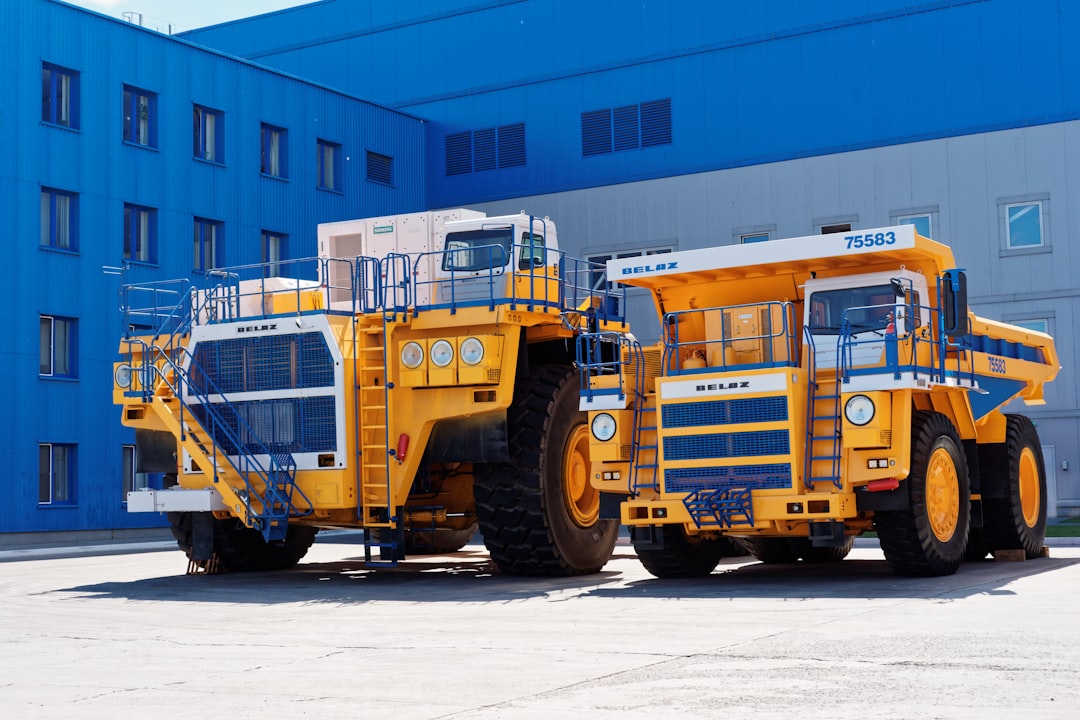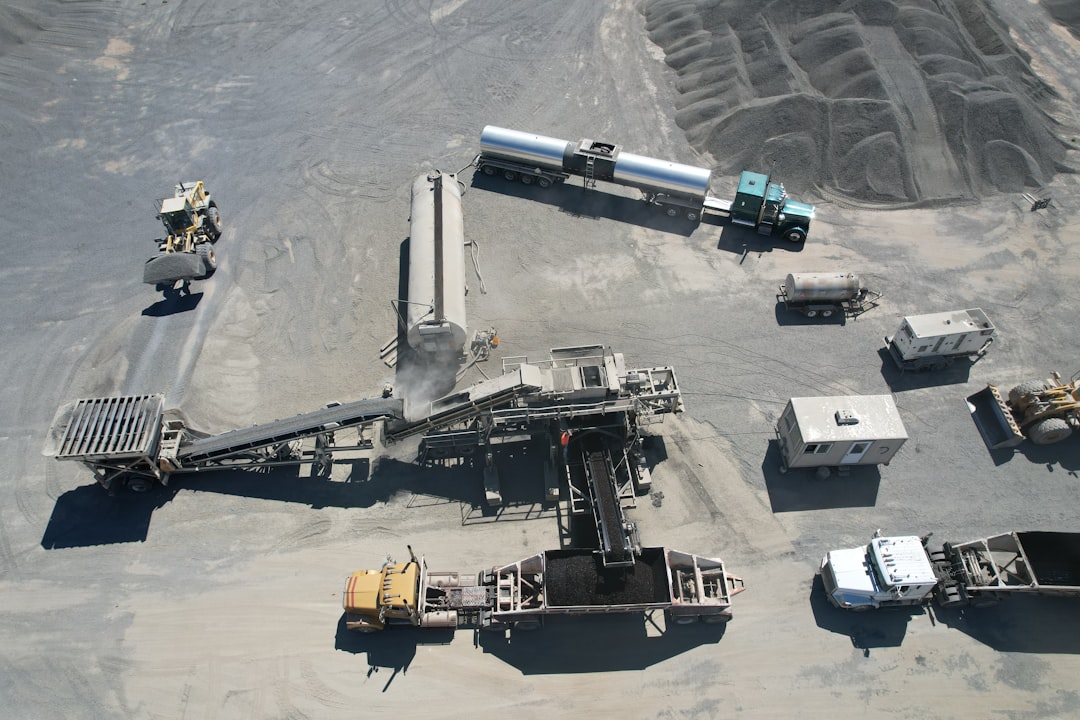

Engage prospects with a scan and streamline customer engagement with FREE QR code marketing tools by Sona – no strings attached!
Create a Free QR CodeFree consultation

No commitment

Engage prospects with a scan and streamline customer engagement with FREE QR code marketing tools by Sona – no strings attached!
Create a Free QR CodeFree consultation

No commitment
The world of heavy equipment cleaning services is rapidly evolving, with increasing demands for operational efficiency, regulatory compliance, and environmental sustainability. As construction, infrastructure, and industrial sectors depend more on heavy machinery, properly maintaining and cleaning this equipment becomes critical for safety, uptime, and cost control.
Many businesses continue to use outdated methods such as paper checklists, static schedules, and manual recordkeeping, which stifle productivity and increase compliance risk. A major problem is the lack of tracking: when cleaning or inspections are not recorded in the CRM, key actions and leads remain unrecognized, missing opportunities for validation or upsell.
Limited visibility into who interacts with cleaning services further complicates efforts to prove compliance or demonstrate value to clients. By bridging on-site operations with digital systems through QR codes, heavy equipment cleaning services can create instant connections between physical equipment and digital workflows, unlocking efficiency and actionable insights.

Traditional paper forms and analog tracking often miss critical cleaning activities, which raises risk for providers and clients. Gaps in documentation can result in compliance failures, rework, and lost revenue opportunities. QR codes connect physical processes to digital results, making it easier to capture maintenance events, streamline scheduling, and improve safety and compliance without adding extra steps for crews.
Start by identifying where analog processes slow you down. Replace paper logbooks with QR-driven digital forms, swap phone tag for instant scan-and-request workflows, and move static SOP binders into dynamic, always-current resources reachable by a scan. Once scans become the default action at the point of work, your field data becomes timely, complete, and usable for audits or client reporting. Explore Sona QR’s use case library for implementation ideas.
Real-time digital inputs replace static logs, enabling teams to satisfy regulators while reducing manual workload. QR-powered solutions also provide visibility into who interacts with your processes, updating CRM records automatically for unified data tracking. With Sona QR, you can create dynamic codes, collect field data, and pipe it directly into systems like Salesforce or HubSpot for accurate reporting.

Heavy equipment cleaning services must keep intensive schedules, uphold safety, and prove regulatory compliance, but fragmented or outdated data hinders outreach and engagement. QR codes give crews, supervisors, and clients a simple way to act at the point of need, while giving the business a complete data trail for operations and sales follow-up.
The technology is particularly effective in rugged, low-connectivity environments where downloading apps is impractical and paper documents degrade quickly. By standardizing on a single, scannable action, you reduce training time, simplify proof of service, and keep your compliance posture strong even as sites change.
These benefits improve client satisfaction, reduce cycle times, and protect margins. They also strengthen your brand’s position as a safety-forward, compliance-ready partner to contractors and plant operators.
Heavy equipment environments call for QR formats that prioritize action and accountability. The most valuable formats streamline cleaning documentation, centralize reference materials, and remove barriers to support requests or approvals.
In heavy equipment cleaning services, forms and web links tend to deliver the highest operational value because they turn point-of-work scans into auditable records. With Sona QR, you can generate each of these formats and manage them in a single dashboard, making it easy to maintain brand consistency, update destinations, and analyze performance across deployments.

QR codes shine wherever a physical task or document needs a digital counterpart. In heavy equipment cleaning services, the best placements are close to operators and supervisors who are responsible for safety, uptime, and site compliance. Make each scan both useful for the user and valuable for your business intelligence.
Consider a layered deployment: codes on equipment for logs, codes in maintenance rooms for SOPs, codes on invoices for feedback and renewals, and codes on signage for visitor safety briefings. Each placement becomes a small, trackable conversion point that supports operations while growing your pipeline. For public screens, see how QR and digital signage work together, and for reviews on invoices, try this guide to Google reviews.
Each scan captures data that refines marketing and sales strategies. Over time, you will learn which placements drive the most value, which roles scan most often, and where to focus for cross-sell or upsell opportunities.

Industry-specific challenges require digital solutions that work at the point of action. The right QR deployments align with how crews operate, how supervisors document, and how clients validate work.
You can expand these use cases with media capture and automation. For example, require photo uploads of before-and-after conditions, route urgent requests to dispatch Slack channels, and trigger automated emails to clients with a summary of work logged that day. When every scan feeds a consolidated system like Sona QR, you gain both operational control and stronger client-facing proof.
Each QR scan is a micro-conversion that reveals intent, context, and urgency. By deploying unique codes across equipment, sites, invoices, and marketing materials, you can segment audiences automatically and personalize follow-ups.
Think in terms of roles, lifecycle stage, and environment. A foreman scanning a safety SOP has very different needs than a procurement manager scanning a proposal link on an invoice. By tagging scans by location and purpose, you can trigger sequences that make your outreach relevant instead of generic.
With Sona QR, each code becomes a smart entry point to your funnel. You can build audiences based on real behaviors, then deliver targeted content that advances the conversation, including intent-driven retargeting strategies for higher ROI.
QR codes are connective tissue across offline and digital touchpoints. They bring measurability and immediacy to channels that historically lacked attribution, while giving field teams a reliable way to document work in real time. For heavy equipment cleaning services, the most effective mix blends operational placements with marketing placements, so data flows into one system. For measurement fundamentals, see this primer on offline attribution.
Make every channel accountable. When a code appears on a brochure, a jobsite sign, or a service report, it should drive a specific action and feed analytics you can use to improve performance.
With a centralized platform like Sona QR, you can manage all codes, monitor performance, and sync scan data with your CRM and ad platforms. The result is a connected offline-to-online funnel where each interaction is both useful to the user and actionable for your business.
Launching a QR initiative is straightforward when you follow a structured plan. Treat it like any other campaign: start with a clear objective, pick the right format, design for the environment, and measure results. The following steps provide a repeatable framework you can use for operational deployments and marketing campaigns alike.
You can adapt these steps for specific goals such as eliminating paper logs, accelerating compliance documentation, increasing upsells on invoices, or capturing trade show leads. The key is to align every code with a single, measurable action and to make that action crystal clear at the point of scan.
Clarify the business outcome you need. Common goals in heavy equipment cleaning services include reducing paperwork, creating defensible audit trails, speeding dispatch, increasing renewals, and generating project-based upsells. Select one goal per code, and define how you will measure success.
Map the user’s context. For example, a code on an excavator should launch a short cleaning log with photo upload, while a code on an invoice should launch a renewal form or add-on selection. Avoid catch-all links that create confusion or extra steps. For campaign ideas, skim QR codes in marketing.
Pick a format that matches your objective and need for flexibility. Static codes are fine for permanent information like a general safety overview. Dynamic codes are best when you need tracking, editing after deployment, or personalized routing by campaign.
In most operational scenarios, dynamic codes deliver higher value because you can update SOP links with zero reprints and track scan volume by site or machine ID. Sona QR supports both static and dynamic codes, along with UTM tagging and device-based routing. Learn more on the product overview page.
Design for the jobsite. Use high-contrast frames, large code sizes, and weatherproof labels. Add your logo and a concise CTA like Scan to Log Cleaning, Scan for SOPs, or Scan to Renew Service. Place the code in a reachable, glare-free location and set minimum size based on scanning distance.
Test extensively. Check multiple devices, angles, and lighting conditions, including low light or harsh sun. Validate the landing experience: does the form load fast, is it mobile friendly, and are required fields minimal? Confirm that submissions route to the correct systems and notifications.
Roll out in phases, starting with high-traffic assets and locations. Prioritize equipment dashboards, cleaning stations, maintenance rooms, and invoices for maximum operational impact. For growth, add codes to brochures, direct mail, and trade show materials linked to demos or ROI tools.
Document placements and maintain a registry. Include code IDs, destinations, and physical locations. This makes troubleshooting and performance reviews simple, and it helps you standardize across sites and regions.
Instrument your codes with UTM parameters and campaign names so every scan is attributable. Monitor scan volume, completion rates, and downstream actions like form submissions, requests, and renewals. Use these insights to iterate on CTAs, form length, and placement.
Automate follow-up. With Sona QR, you can sync scan events to HubSpot or Salesforce, trigger reminders for missed cleanings, and alert sales of high-intent actions like proposal views. Continuous optimization will compound results over time. For fundamentals, revisit marketing revenue attribution.
A rigorous checklist is the difference between a novelty deployment and a revenue-driving program. By standardizing these steps, you create a scalable framework that works across equipment types, sites, and campaigns.
Without connected data, it is hard to link field activity to performance outcomes like reduced downtime, faster audits, or increased renewal rates. QR tracking solves this gap by capturing every interaction at the source and pushing those signals into your analytics and CRM stack.
Treat each code as a conversion point. You should know who scanned, when they scanned, where they were, and what they did next. That clarity makes it possible to optimize both operations and marketing spend, while giving clients transparent proof of value.
Sona QR captures real-world engagement. Sona.com turns that engagement into insights you can act on, helping you connect scans to revenue, safety improvements, and compliance milestones. This is how you evolve QR from a convenience tool into a performance engine.
Once your foundational deployments are in place, look for ways to deepen value and scale with confidence. Focus on unique codes, clean attribution, and automation that keeps the journey moving without adding manual tasks for your team.
Select the practices that best match your environment. In heavy equipment cleaning services, codes must be durable, scannable in tough conditions, and clearly tied to a single action to avoid confusion at the point of work.
You can generate and track your first QR codes for free with Sona QR. Start creating QR codes for free. Set up tags, UTM parameters, and integrations from day one to build a strong measurement foundation.

Practical examples show how QR codes convert real-world actions into measurable outcomes. These scenarios illustrate how incremental improvements in logging, communication, and follow-up add up to significant gains in efficiency and revenue.
Use the ideas below as starting points, then adapt the placements, CTAs, and destinations to your own workflows, client expectations, and brand positioning.
For creative deployments, consider magnet-backed codes on temporary equipment panels, tamper-evident labels for waste handling documentation, or color-coded frames that indicate the purpose of each code at a glance. These small design choices improve adoption and reduce scanning errors.
Succeeding with QR programs requires thoughtful design, clear intent, and ongoing maintenance. The same elements that make QR simple for users also make it easy to deploy poorly if you are not careful about placement, messaging, and link hygiene.
Avoid set-it-and-forget-it thinking. Make QR a living part of your operational and marketing systems, with periodic reviews, updates, and training refreshers.
By following these practices and avoiding common pitfalls like tiny codes, vague CTAs, or broken links, you ensure your QR deployments deliver measurable improvements.
QR codes are a strategic asset for heavy equipment cleaning services. They turn every machine, sign, and document into an entry point for engagement and proof, while providing the data backbone required for compliance, client reporting, and growth. When integrated with your CRM and analytics stack, scans reveal who engaged, where they engaged, and what happened next.
The path forward is practical and measurable. Equip your assets with purpose-built codes, design clear CTAs, and route each scan to a fast, mobile-friendly experience. Use Sona QR to centralize creation, tagging, and analytics, and connect to Sona.com for advanced attribution that ties field engagement to pipeline and revenue.
With Sona QR, you have everything needed to capture demand at the source, prove compliance with confidence, and convert offline activity into measurable results. Start by generating your first codes, attach them to high-impact placements, and watch how quickly clarity and control improve across your heavy equipment cleaning services.
QR codes have transformed the heavy equipment cleaning services industry by turning routine maintenance into a streamlined, data-driven process. By enabling instant access to cleaning histories, service schedules, and compliance records, QR codes enhance operational efficiency and transparency. Imagine your team instantly retrieving detailed service information right at the equipment site, reducing downtime and ensuring top-tier cleanliness every time.
With Sona QR, you gain the power to create dynamic, trackable QR codes that can be updated in real time without reprinting—perfect for rapidly changing service needs. Every scan provides actionable insights, helping you monitor service quality, improve client communication, and drive repeat business through enhanced customer trust. Start for free with Sona QR today and transform how your heavy equipment cleaning services connect with clients and optimize operations.
The best methods include deploying QR-driven checklists and logs to record completed cleanings, using digital forms to capture photos and timestamps, and following up with site-specific SOPs accessible via QR codes to ensure consistent and up-to-date cleaning protocols.
Cleaning frequency should be monitored and optimized using QR code scan analytics that track cleaning events by unit, shift, or site, enabling adjustments based on operational needs and compliance requirements.
Specialized heavy equipment cleaning services use technologies like QR codes to streamline cleaning documentation, ensure regulatory compliance, and provide verifiable audit trails, with providers such as those utilizing platforms like Sona QR offering integrated digital solutions.
QR codes improve operational efficiency by replacing paper logs with instant digital records, enhance compliance through verifiable timestamps and operator IDs, simplify access to SOPs and safety documents, enable real-time tracking and analytics, and reduce administrative workload and costs.
By placing QR codes on equipment that link to digital cleaning logbooks and maintenance records, you can capture detailed, timestamped data including photos and operator information, which feeds directly into CRM and analytics platforms for real-time tracking and comprehensive maintenance history.
Use Sona QR's trackable codes to improve customer acquisition and engagement today.
Create Your FREE Trackable QR Code in SecondsJoin results-focused teams combining Sona Platform automation with advanced Google Ads strategies to scale lead generation

Connect your existing CRM

Free Account Enrichment

No setup fees
No commitment required

Free consultation

Get a custom Google Ads roadmap for your business






Launch campaigns that generate qualified leads in 30 days or less.
